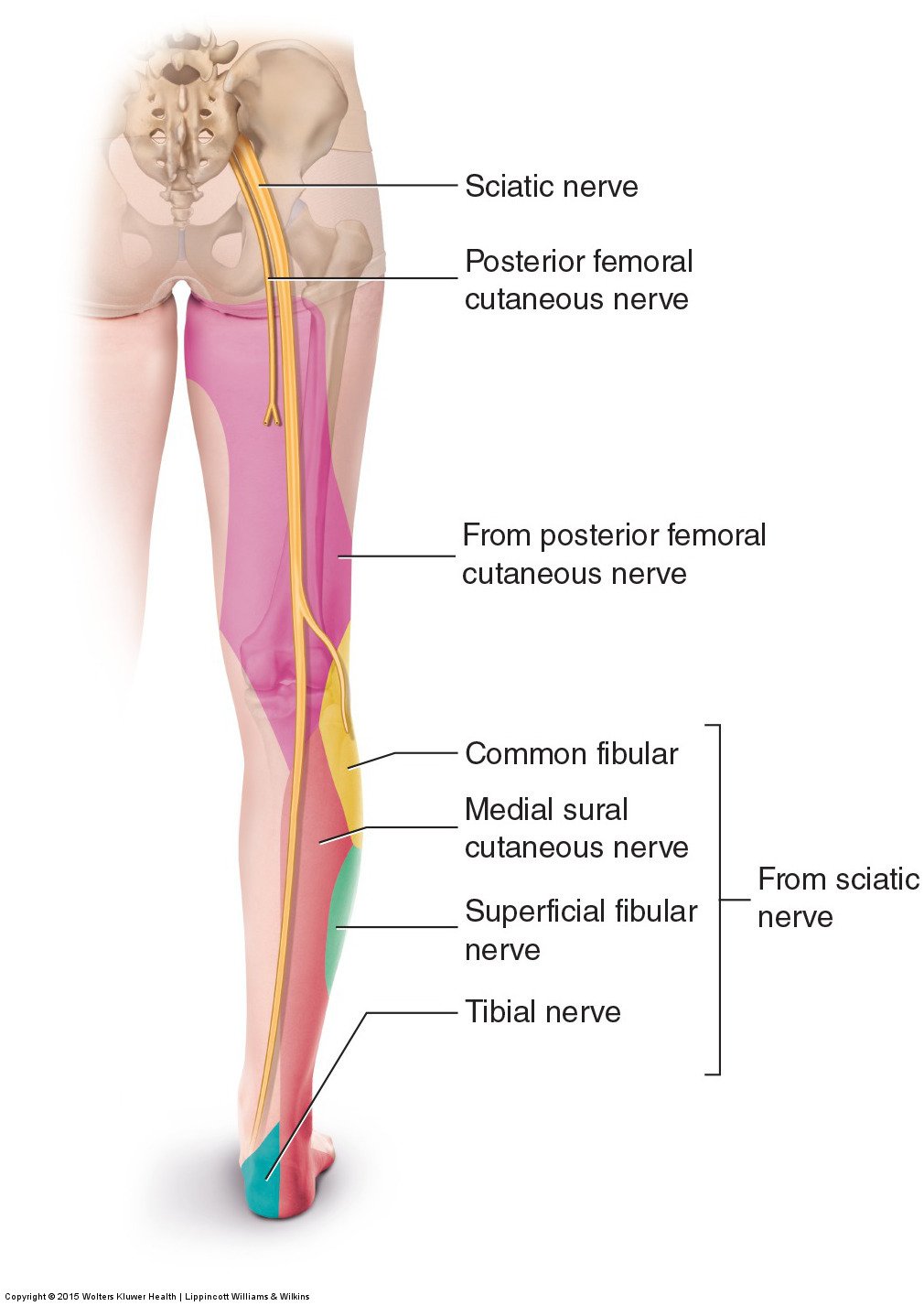Signs and symptoms of sciatica
Compression upon the sciatic nerve can decrease its transmission by partially or entirely blocking the ability of neurons to carry their signals. This can result in numbness or decreased sensation (hypesthesia) within the innervation region of the sciatic nerve (note: the term “paresthesia” is used to denote any altered sensation). In addition to symptoms within the innervation region of the sciatic nerve, pain along the course of the sciatic nerve within the buttock or posterior thigh is also possible. Indeed, pain shooting down the posterior thigh is a fairly common symptom for clients/patients experiencing sciatica.

Sensory innervation of the sciatic nerve into the lower extremity. Permission: Joseph E. Muscolino. Permission: Joseph E. Muscolino. Manual Therapy for the Low Back and Pelvis – A Clinical Orthopedic Approach (2015).
Decreased signal conduction within the motor neurons of the sciatic nerve can result in weakness of the musculature innervated by the sciatic nerve. A very common sign of sciatica is “foot drop.” The term foot drop describes the characteristic manner in which the foot drops against the ground during the gait cycle because of the weakness of ankle joint dorsiflexors. When weakened, dorsiflexion musculature is not strong enough to eccentrically contract to gracefully control the descent of the foot as we step forward. Therefore, instead of lowering against the ground with control, the foot drops against the ground, often making a slapping noise.
Conversely, compression can increase nerve signal conductance if the compression irritates the neuron, triggering action potentials. If sensory neurons are irritated, the client/patient might have tingling, increased sensitivity, or pain (hyperesthesia) within the innervation region of the sciatic nerve. If sciatic motor neurons are irritated, twitching or spasming of the associated musculature might occur.
The exact location of the symptoms of sciatica would be determined by which neurons are compressed; in other words, which nerve root level is affected (from L4 to S3), and whether they are sensory or motor neurons. Given the location of the sciatic nerve and its wide expanse of sensory distribution, the symptoms could range from sharp pain in the posterior thigh, to burning discomfort in the lateral leg, to numbness in the big toe. Similarly, motor symptoms can potentially range from twitching or spasming of the hamstrings, to weakness of musculature of the foot or toes.
If sciatica is caused by a space-occupying lesion (nerve compression) within the intervertebral foramen (IVF), whether it is a pathologic disc or an osteoarthritic bone spur, then anything that compresses and narrows the IVF will likely increase the symptoms of sciatica. For this reason, positions of weight bearing (sitting and standing) often increase the symptomology of sciatica. Spinal extension can also be problematic because it decreases the size of the IVFs, thereby likely increasing compression upon the nerve roots. If the cause of the sciatica is a pathologic disc, then spinal flexion can also be difficult for some clients/patients because it compresses the anterior disc, driving the nucleus pulposus posteriorly against the damaged annular fibers, thereby increasing the bulging/herniation pressure against the nerve.


